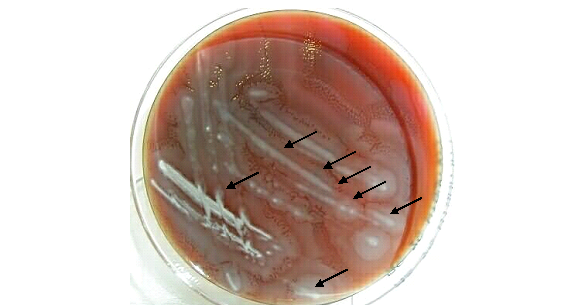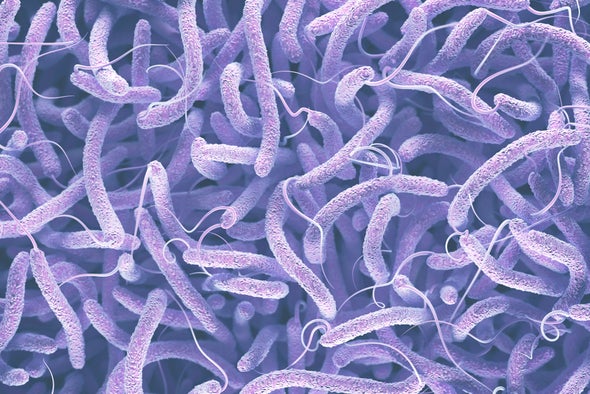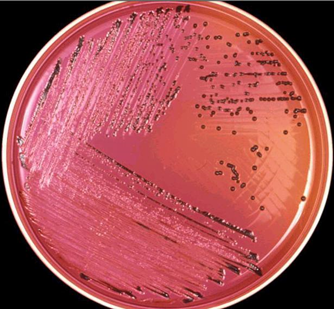Mycobacterium tuberculosis is a slim, non-motile, non-spore forming, Gram-positive, obligate aerobe, and acid-fast bacillus (rod) with a waxy cell wall. It is found in the genus Mycobacterium and family Mycobacteriaceae. Aside M. tuberculosis, M. bovis (cattle/animal pathogen), M. avium and M. leprae (causative agent of leprosy/Hansen’s disease)are the other important species of the genus Mycobacterium that causes disease in humans. Other non-tuberculous Mycobacteria are members of the human normal microflora, found in water surfaces, are non-contagious and are generally referred to as atypical Mycobacteria.
Consumption of unpasteurized (raw) milk and close contact with infected cattle can cause M. bovis infection in humans. The cell wall of all bacteria in the Mycobacterium genus is different and very unique in that their cell wall is made up of high concentrations of lipids containing long chain fatty acids known as mycolic acid (which makes the cell surface of the bacterium hydrophobic). The mycolic acid is very distinct for each species of bacterium in the Mycobacterium genus, and it makes up about 60% of the total cell wall mass of the organism.
M. tuberculosis has a cell wall containing peptidoglycan that is similar to that of other Gram-positive bacteria except that its peptidoglycan contains N-glycolylmuramic rather than N-acetylmuramic acid – typical of all Gram-positive bacteria. The mycolic (fatty) acid content of the cell wall of Mycobacteria species makes them resistant to desiccation and other chemicals such as antibiotics and sodium hydroxide (NaOH) which normally kill or inhibit other bacteria in sputum prior to culturing in the laboratory. However, species of Mycobacterium are sensitive to ultraviolet (UV) rays.
M. tuberculosis and other related species in the genus Mycobacterium are mostly called acid-fast bacilli because they show a tendency of acid-fastness upon staining. The reason for their acid-fastness is attributed to the high mycolic (fatty) acid content of their cell wall which makes them difficult to be stained readily; but once stained, Mycobacterium species resist decolourization by alcohol or acid – a phenomenon that aids in their detection and differentiation from other non-mycolic bacteria. M. tuberculosis is an airborne pathogen responsible for causing an infection known as tuberculosis (TB) in humans, and it is one of the leading causes of death in the world.
The causative agent of TB was first isolated and described by Robert Koch (the father of Medical Microbiology) in 1882 after an extensive research on the matter. Tuberculosis is a chronic infectious respiratory disease that occurs in both man and animals; and it is responsible for over 2 million deaths worldwide according to the World Health Organization (WHO). TB infections are mostly caused by inhaling cough droplets or aerosols containing tubercle bacilli (i.e. viable cells of M. tuberculosis) released by infected individuals.
The human lungs are the main reservoir of M. tuberculosis, and transmission is fastest via respiratory droplets and droplet nuclei in aerosols or dust particles.Tubercle bacilli and respiratory droplets from an infected person are capable to bypass the defenses of the upper airways (nostrils) and become lodged in the alveoli of the lungs of the susceptible individual. Close contact and communication with infected persons can also cause an infection, and the organism affects a wide variety of organs in the body including the lungs, kidneys, spine, meninges, brain, GIT, and blood vessels.
The elderly, health care workers in contact with high-risk populations, people with weakened or impaired immune system, homeless people, prison inmates, alcoholic poor males, intravenous (IV) drug users, malnourished individuals, refugees and overcrowding are some of the predisposing factors and people at risk of developing tuberculosis. Sub-Saharan Africa, some parts of Asia, the Western Pacific and Latin America have one of the highest incidences of TB infection in the world.
TB is an important public health disease that is of global significance due to its mortality and morbidity rate. The disease is re-emerging in some areas, and some resistant M. tuberculosis strains now exist – making it difficult to manage the infection. It is the number one opportunistic infection in people living with HIV/AIDS (PLWHA) and even amongst other immunocompromised individuals.
PATHOGENESIS OF MYCOBACTERIUM TUBERCULOSIS INFECTION
M. tuberculosis is an airborne pathogen, and thus the main route of transmission or acquiring the disease is through the upper respiratory system/airways (Figure 1). An infection with the tubercle bacillus, M. tuberculosis, is usually initiated following an inhalation of microscopic particles in aerosols that originate from an active pulmonary TB disease; and the incubation period of the disease after infection is usually 4-12 weeks.
An exposure to M. tuberculosis may lead to infection, but most infections do not lead to a TB disease depending on the immune state of the affected individual. People with an active pulmonary TB disease expel plethora of infectious microscopic tubercle bacilli into the atmosphere when they sneeze, cough, expectorate/spit or speak. Because the infectious dose of TB is very low (about 5-10 bacteria), inhaling as little as 10 bacteria in an aerosol, droplets or dust particles can cause an infection.

However, individuals with prolonged, frequent, or intense contact with TB disease persons are at particularly high risk of becoming infected than people with lesser contact. The immune system of the human host and the strain of the tubercle bacilli are critical in determining the pathogenesis of the disease – in that people with active immunity tends to resist and contain the disease more than those with a weakened resistance.
After inhalation, the bacterium M. tuberculosis is carried past the upper and middle airways system until it reaches the alveolar surfaces of the lungs where they are deposited. Adjacent lymph nodes are also infected by the bacterium, and small inflammatory lesion is formed around these sites as well. Inside the lungs, alveolar macrophages surround the bacterium by the process of phagocytosis, and this leads to hypersensitivity reaction that forms tubercles (small and hard nodules characteristic of the TB disease).
This is known as primary infection, and in this scenario; the host immune system is able to restrict and contain the tubercle bacillus within the pulmonary system– thus preventing it from spreading and leading to a disease state. At this stage, TB infection is limited, and the lesions formed are self-healing even though all the tubercle bacilli may not be destroyed. People with weakened immune system experience active pulmonary infection, and this leads to the destruction of the lungs and the spread of the pathogen to other parts of the body leading to death.
However, most cases of primary TB infections are usually handled well by the host immune system and the Mycobacterium continues to multiply intracellularly (but under the watch of macrophages) without any significant damage to the host cells. In secondary infection (which may be active pulmonary or extra-pulmonary infection), M. tuberculosis in the lungs becomes reactivated after several months or years due to malnutrition, impaired immunity or poor health condition of the individual.
Secondary (post-primary) infection can also occur when primary infections do not heal effectively and this is usually experienced in about 10% of the primary TB cases. Tubercle bacilli that survived the primary lesion or infection processes are mainly responsible for sparking up a post-primary (reactivation) types of TB. The further course of the TB disease (i.e. from primary to secondary infection) depends on the outcome of the encounter between the host’s specific cell-mediated immunity (CMI) and the tubercle bacilli itself.
CMI is usually protective and lifelong in some TB infected individuals. But in some other cases, the tubercle bacilli or particles become dislodged from their containment by the mechanisms of the CMI into the host’s airways later in their lifetime, and this occurs when there is a significant reduction in the individual’s T-cell immune response. At this stage, the pathogen multiplies sporadically in the host’s body, dissemination to vital body begins and the TB disease symptoms start to emanate.
The clinical signs and symptoms of TB (i.e. in secondary infection) which only appears in pulmonary TB or extra-pulmonary TB (i.e. when the disease becomes active) and may resemble other lung/respiratory diseases include loss of appetite, chest pain, prolonged and productive coughs with blood, fever, unexplained weight loss, poor growth in children, and fatigue.
The disseminated forms of TB which emanate from a secondary infection include military TB (which affect the spleen, lymph glands and liver due to dissemination of the pathogen via blood), tuberculosis meningitis (which affect the brain and meninges), renal and urogenital tuberculosis (which affect the GIT and kidney) and bone and joint tuberculosis (which affect the spinal cord or vertebrae).
DIFFERENCES BETWEEN A TB INFECTION AND A TB DISEASE
It is noteworthy that an infection with M. tuberculosis does not necessarily connote that someone has a TB disease. Exposure to aerosols, dust particles and respiratory droplets (e.g. sputa, sneeze and cough from an infectious TB patient) containing sufficient amount or dosage of tubercle bacilli is the first basis for the acquisition of M. tuberculosis bacteria. Whether the exposure that led to an infection will consequently result into a TB disease is dependent on so many factors including the strain of the infecting pathogen, the state of the host’s immunity, host’ health condition amongst others.
TB infection and TB disease are quite two different phenomenons. While the former (i.e. TB infection) presents no clinical symptom, is not infectious, has a normal chest X-ray results and shows a negative sputum smear and culture test results; the latter (i.e. TB disease) presents with clinical symptoms (cough, fever, and weight loss), is infectious, chest X-ray reveals lesions, and sputum smear and culture test results are positive. In both cases of a TB infection and TB disease, the bacterium M. tuberculosis is always present and skin (tuberculin) test results are always positive in these individuals.
However, people with a TB infection are not infectious (i.e. they cannot spread the infection to other people) but people with a TB disease can easily transmit the causative agent of TB to susceptible non-infected individuals. People with a TB infection have M. tuberculosis in their body but the immune system of these individuals has developed an immune system mechanism that contains the pathogen and keeps it under control.
TB remains dormant throughout life in most people who are infected with M. tuberculosis but this is not the case with a person with TB disease because such an individual has an active infection. TB transmission can only occur from people with active TB disease and not latent or dormant TB. Thus, exposure, latent TB infection and TB disease are often the three (3) main ways of describing the stages of tuberculosis clinically.
LABORATORY DIAGNOSIS OF MYCOBACTERIUM TUBERCULOSIS INFECTION
The primary specimen for the laboratory diagnosis of a potential TB disease is sputum that is collected in a screw-cap, leak-proof sample container. The reason for using a screw-cap, leak-proof sample container in collecting sputum instead of the usual snap-closing containers is to minimize the spread of the disease or pathogen through aerosols which non-screw-capped, leak-proof sample containers are capable of initiating.
Blood, laryngeal swab, bronchoscopic specimens, pleural and peritoneal fluids, gastric lavage and CSF can also be collected from infected patients and analyzed for other TB types. Culturing and microscopic technique are usually the two main methods used for the detection of M. tuberculosis from sputum. Mantoux (tuberculin) skin test, DNA probe testing kits for TB, PCR and chest X-ray are other diagnostic tools or measures used for the clinical diagnosis of the disease.
However, the isolation of the acid-fast bacterium in culture and a positive microscopic staining technique are often the two most reliable methods for detecting the pathogen. Though M. tuberculosis is a Gram-positive bacterium, the Gram staining technique does not readily stain the pathogen because of the very high content of lipid (i.e. mycolic acid) in its cell wall. Ziehl Neelsen, Kinyoun and fluorescence stains are the main stains or staining techniques used in the laboratory for the identification of M. tuberculosis and the other related species in the genus Mycobacterium.
The selective isolation of M. tuberculosis from sputum and other clinical samples is made possible because of the high fatty acid content of its cell wall. Sputum smears are to detect M. tuberculosis, and when stained with Ziehl Neelsen staining technique, the bacterium stains red (as shown in Figure 2) due to the mycolic (fatty) acid content of the organism’s cell wall. Staining with fluorochrome stains (e.g. rhodamine and auramine) demonstrates or shows a yellow-orange fluorescence under the microscope.
The scanning electron micrograph of M. tuberculosis is shown in Figure 3. Culturing of sputum specimen for the detection of M. tuberculosis is usually performed in Reference Tuberculosis Laboratories due to the expensive nature of this procedure using selective such as the Löwenstein-Jensen (Middlebrook) culture medium (Figure 4). M. tuberculosis should be cultured for identification purposes and antimicrobial susceptibility testing.
Selective media such as the Löwenstein-Jensen medium (Figure 4) is used for the isolation of the bacterium. Because the tubercle bacteria are slow growing, culture medium are normally incubated for weeks and at a temperature range of 35-37oC. In summary, the diagnosis of tuberculosis requires the detection of acid-fast bacilli (AFB) in sputum of infected patients through the Ziehl-Neelsen stain or other reliable staining techniques as previously stated. Then this must be followed by culturing in a selective media for the identification of the pathogen and consequently to determine their susceptibility profiles.
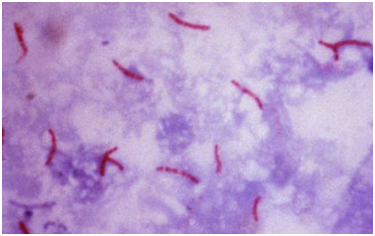
TB bacterium is shown in red (arrows). In Ziehl Neelsen staining technique, a mixture of carbol fuchsin (a basic dye) and phenol is used. The stain is driven directly into the cell wall of the tubercle bacilli by the slow heating of the smear on the microscope slide. Slides are usually heated to steaming point for about 2-3 min. The phenol enhances the penetration of the carbol fuchsin dye into the mycolic acid cell wall of M. tuberculosis, and acid-fast bacillus (AFB). The slide is washed in distilled water and decolorized with acid-alcohol; and it is washed again and finally stained with a counter stain known as methylene blue. Non-AFB bacteria take up the colour of the counter stain while M. tuberculosis when present appears red under the microscope.
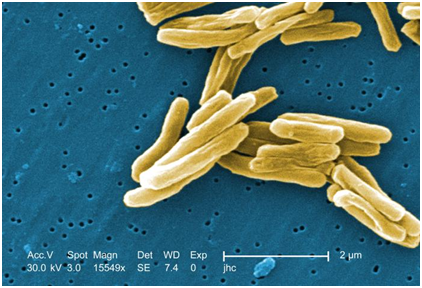

IMMUNITY TO MYCOBACTERIUM TUBERCULOSIS INFECTION
If the tubercle bacilli do not kill its human host, there is a great tendency of the individual to develop a certain level of defense against the pathogen. Innate immunity against M. tuberculosis infection is very high in humans but this form of protection varies and depends on the genetic makeup of the individual. The host’s immune system mechanisms help to localize the Mycobacteria, impede their growth and spread in the body.
First exposure to M. tuberculosis also develops some appreciable levels of protection in the host’s body due to CMI. CMIactually develops when competent T cells recognize tubercle antigen complexes on the surface of macrophages containing M. tuberculosis. Both cells of the CMI (i.e. CD8+ and CD4+) are involved in protecting the individual from tubercle bacilli infection, but acquired immunity in TB infection is incomplete or shortened.
Damage to the lung of individuals infected with M. tuberculosis could be prevented if alveolar macrophages respond and appear early enough in the infection process. These alveolar macrophages join to form cells that combine with the CMI to produce a granulomatous reaction that walls off the growing tubercle lesion.
Tubercle bacilli only survive in this lesion during the period of dormancy (i.e. primary infection), and may become reactivated when the host’s CMI is diminished following other health problems such as HIV or immunosuppressive drugs which repress the immune system of the individual. Humoral immunity does not eliminate a TB infection, rather it is the CMI that confers defense and eventually leads to recovery and protection of the affected host from a possible re-infection with a new strain of M. tuberculosis in the future.
TREATMENT OF MYCOBACTERIUM TUBERCULOSIS INFECTION
The successful treatment of TB disease is usually undertaken using multiple drugs to which the tubercle bacilli are susceptible to due to the possibility of the Mycobacteria in developing resistance to a single anti-tuberculosis drug. Thus, single drug regimens are often ruled out when considering therapy for a TB disease patient. Isoniazid (INH) and rifampin are the two drugs of choice used as first-line TB drugs for the treatment and management of a TB disease.
Other first-line TB drugs are ethambutol, pyrazinamide and streptomycin (an injectable TB drug). The second-line TB drugs include kanamycin (injectable), ofloxacin, capreomycin (injectable), amikacin (injectable), ethionamide, ciprofloxacin and cycloserine. Initial TB therapy is usually started with about three – four TB drugs that include the 2 first-line drugs (INH and rifampin) especially when susceptibility studies are still underway. But when susceptibility results become available, a two-drug therapy is given to the patient except in cases when resistance is anticipated, then the drugs can increase to three or four.
The course of drug therapy for TB disease usually spans a period of 9 months in which INH and rifampin are administered concomitantly on a daily basis for about 2 months. TB therapy normally takes a longer period to complete because the pathogen is a slow growing organism, and thus longer time is required to kill them. The use of two drugs in TB treatment helps to prevent the emergence of tubercle bacilli resistant to each of the drug.
Second-line TB drugs are used and included in TB therapy when there is toxicity or resistance associated with any of the first-line drugs. Treatment with multiple anti-TB drugs helps to eradicate the tubercle bacilli and prevent the emergence of resistant strains or spread of the infection to non-TB individuals. In most cases, a direct observed therapy (DOT) in which the patients visits the health center or clinic to take their medication.
DOT is anti-tuberculosis program where TB patients are regularly monitored to ensure that they take the full course of their medication so that resistance does not develop and the public health is protected. But when patients fail to comply with their TB regimen, the infection becomes reactivated and the individual becomes infectious again. Resistance of M. tuberculosis to TB drug treatment is now a global health problem, and it usually develops in places where anti-TB treatment is poorly funded.
Patient’s non-compliance to their drugs and use of ineffective or counterfeit drugs also contribute to the development of resistance. Blind treatment which is usually resorted to in most instances before a proper susceptibility test result is obtained also adds up to the development of drug resistant M. tuberculosis. M. tuberculosis strains that are multidrug-resistant (MDR) and extensively drug-resistant (XDR) now exist and these has added to the dilemma associated with the global containment and eradication of the TB disease.
Multidrug-resistant TB (MDR-TB) are M. tuberculosis strains that are resistant to at least one of the two best first-line TB treatment drugs (isoniazid and rifampin) while extensively drug-resistant TB (XDR-TB) are M. tuberculosis strains that are resistant to the two best first-line TB treatment drugs (isoniazid and rifampin), plus any fluoroquinolone and at least one of the three injectable second-line TB drugs (amikacin, kanamycin, or capreomycin). Streptomycin is also an injectable second-line TB drug.
In some parts of the world such as the United States of America and Europe, TB disease has been contained to some extent and cases of new incidence of the disease are rare. Thus, infectious rates of the disease in these regions are very low. However, TB disease still contributes to the global bacterial disease morbidity and mortality rate especially in the developing countries where cases of new incidence of the disease is still being reported (Figure 5).
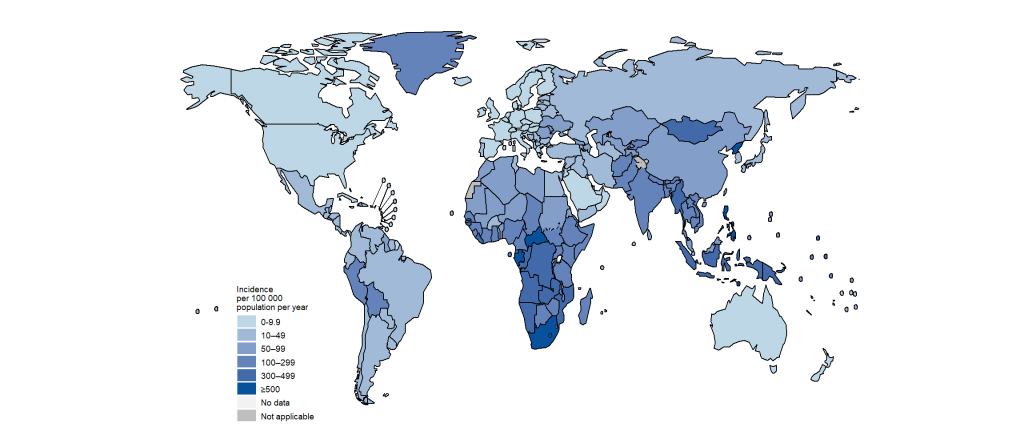
PREVENTION AND CONTROL OF MYCOBACTERIUM TUBERCULOSIS INFECTION
The prevention and control of TB is critical to the global public health. Individuals that present with a positive tuberculin skin test but no active TB are considered to have a dormant type of TB, thus such individuals should be placed under intensive TB therapy using INH so that the infection does not progress to a disease state at a later time. The development of novel anti-TB drugs, availability of proper diagnostic tools for prompt/early TB detection and adequate susceptibility tests are fundamental to the containment of this man-killer disease known as TB.People living in high risk regions should be vaccinated with the Bacilli Calmette-Guerin (BCG) vaccine.
It should also be administered to infants and children so as to protect them from the infection. BCG is a live attenuated bovine vaccine derived from M. bovis; and the name “BCG” was from the two French scientists (Calmette and Guerin) that developed the vaccine in the early 1920’s. Individuals who receive the BCG vaccine develop a positive mantoux skin test because the components of the vaccine induce a DTH in the recipients. BCG vaccine is contraindicated in HIV-infected individuals, and the vaccine should not be used in such cases.
The chain of transmitting M. tuberculosis can be broken by isolating active pulmonary TB disease patients from the general population and starting effective anti-tuberculous therapy on them. Travelers should avoid close contact with known TB patients, and TB disease patients under treatment for TB should not travel until the treating physician has documented, by laboratory examination of sputum and other diagnostic protocol, that they are not infectious and are therefore of no risk to others in terms of passing on the tubercle bacilli to susceptible individuals they might be coming in contact with. Potentially contaminated air is treated with UV rays to avoid contamination.
OTHER SPECIES OF MYCOBACTERIUM
- Mycobacterium leprae: M. leprae is the causative agent of leprosy.
- Mycobacterium africanum: M. africanum is found in humans and monkeys.
- Mycobacterium kansasii: M. kansasii is found in water and cattle.
- Mycobacterium ulcerans: M. ulcerans is found in humans and in the environment.
- Mycobacterium avium complex: M. avium complex is found in birds, fowl, soil, water, cattle, swine, and in the environment.
- Mycobacterium bovis: M. bovis is found in cattle and humans.
- Mycobacterium genavense: M. genavense is found in pet birds.
- Mycobacterium malmoense: M. malmoense is found in the environment.
- Mycobacterium marinum: M. marinum is found in fish and water.
- Mycobacterium simiae: M. simiae is found in monkeys and water.
- Mycobacterium xenopi: M. xenopi is found in water and birds.
- Mycobacterium gastri: M. gastri is found in gastric washings.
- Mycobacterium fortuitum: M. fortuitum is found in soil, water, marine life and animals.
- Mycobacterium chelonae: M. chelonae is found in soil, water, marine life and animals.
- Mycobacterium fallax: M. fallax is found in soil and water.
- Mycobacterium gordonae: M. gordonae is found in water.
- Mycobacterium flavescens: M. flavescens is found in soil and water.
References
Brooks G.F., Butel J.S and Morse S.A (2004). Medical Microbiology, 23rd edition. McGraw Hill Publishers. USA. Pp. 248-260.
Madigan M.T., Martinko J.M., Dunlap P.V and Clark D.P (2009). Brock Biology of microorganisms. 12th edition. Pearson Benjamin Cummings Publishers. USA. Pp.795-796.
Prescott L.M., Harley J.P and Klein D.A (2005). Microbiology. 6th ed. McGraw Hill Publishers, USA. Pp. 296-299.
Ryan K, Ray C.G, Ahmed N, Drew W.L and Plorde J (2010). Sherris Medical Microbiology. Fifth edition. McGraw-Hill Publishers, USA.
Singleton P and Sainsbury D (1995). Dictionary of microbiology and molecular biology, 3rd ed. New York: John Wiley and Sons.
Talaro, Kathleen P (2005). Foundations in Microbiology. 5th edition. McGraw-Hill Companies Inc., New York, USA.
Discover more from Microbiology Class
Subscribe to get the latest posts sent to your email.


